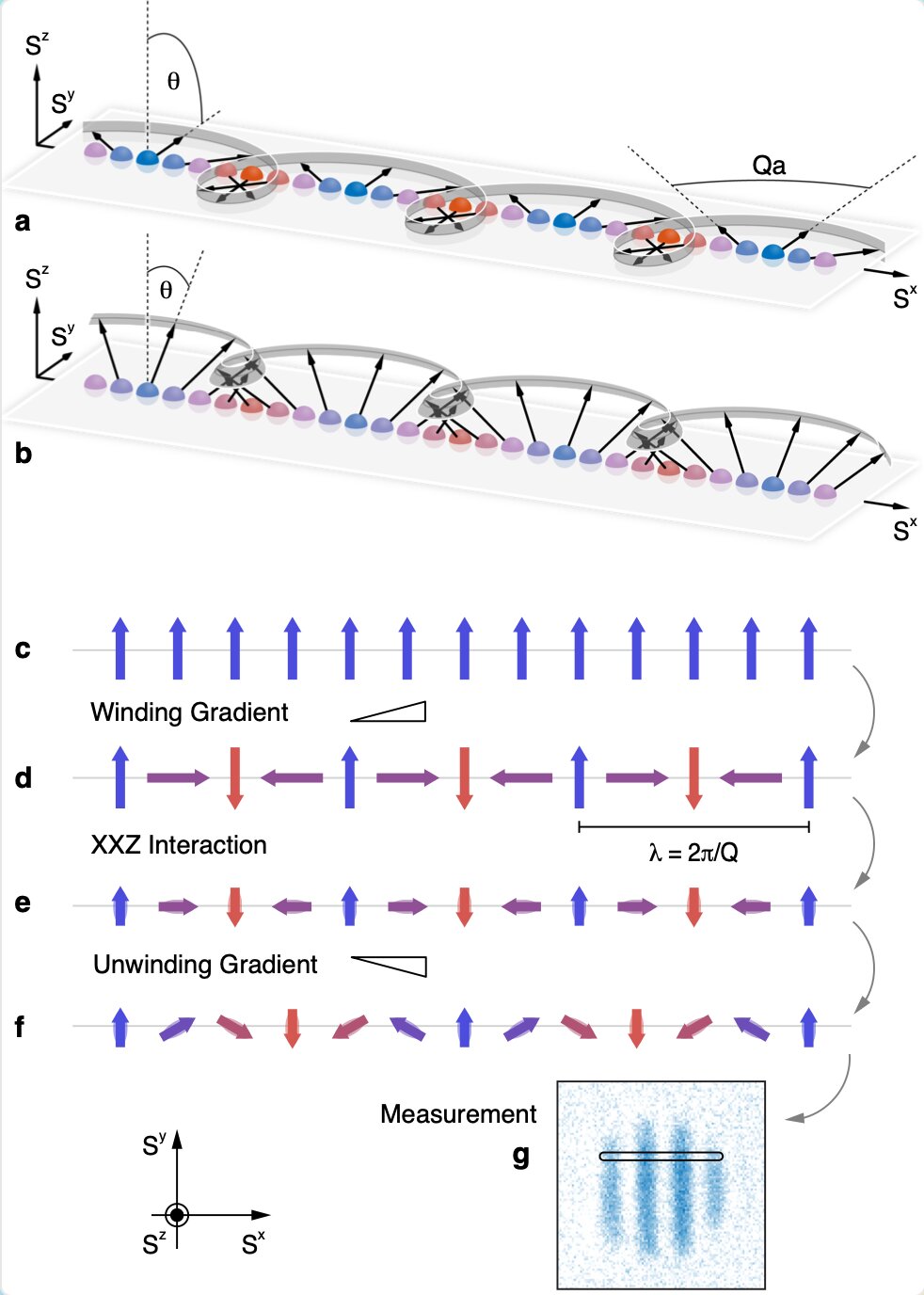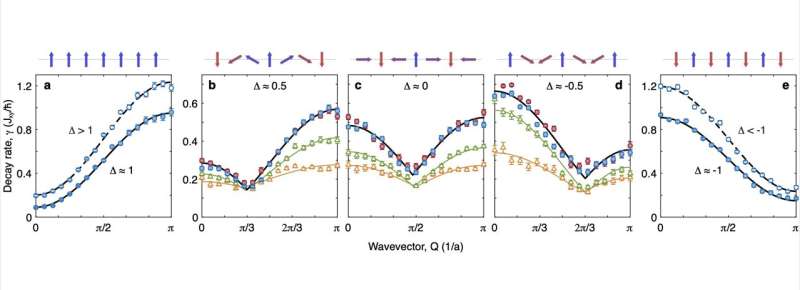

Researchers at Massachusetts Institute of Technology (MIT), the MIT-Harvard Center for Ultracold Atoms, Harvard University and Stanford University have recently unveiled the existence of unique helical spin states in Heisenberg quantum magnets. Their observations, published in a paper in Nature Physics, could have important implications for the simulation of spin-related physical processes and dynamics in quantum many-body systems.
“When we started this project, our primary goal was to investigate the dynamics of quantum magnetism,” Eunice (Yoo Kyung) Lee and Wen Wei Ho, two of the researchers who carried out the study, told Phys.org. “Quantum magnetism underlies many of the technologies we use today, including memory storage devices, and is thus of fundamental interest.”
To model quantum magnetism, one can depict each elementary particle as carrying a spin (e.g., like a spinning top), which can point in different directions. In this context, two nearby spins can exchange their relative orientations via an intermediate state with both particles in the same place.
“This idea is captured by a simple textbook model called the Heisenberg spin model, which we can realize in one dimension (i.e., a chain) in our experimental platform using ultracold atoms,” Lee explained. “Generically if we prepare a simple pattern of spins, say all spins aligned, then over time the pattern gets messed up: there will be a random mixture of spins pointing in all different directions. This process, known as thermalization, is what eventually destroys information.”

A recent study by a team of theoretical physicists at University of Wuppertal and University of Ljubljana suggested the existence of a simple pattern of spins that does not evolve at all and is thus less affected by thermalization. These spins, spiraling along the chain in the x-y plane and with a certain pitch, are known as “phantom helix states.” In contrast to other states, phantom helix states should theoretically be able to store information for very long periods of time.
“The Heisenberg model is almost one hundred years old, so we were especially excited by these surprising new ‘phantom helix states’ and set out to observe them,” Lee said. “To do so, we had to prepare a spin-helix state with a particular wavelength, then watch how the contrast of the helix (i.e., the amplitude of our sinusoidal spin pattern) decayed over time. If the phantom helix state existed, we would see a minimum in the decay rate of the contrast. We indeed did observe this minimum, telling us that we found the long-lived phantom helix states that we were looking for!”
The recent paper by Lee and her colleagues also builds on their past studies, particularly in terms of the strategies they used to characterize how the contrast of the system would decay over time. To confirm that the decay rates they observed were consistent with theoretical predictions, they also used calculations carried out by Wen Wei Ho, one of their collaborators, in a previous paper.
The goal of their new study was to observe the “phantom” helix states (i.e., states that contribute zero energy but finite momentum) predicted by theorists at University of Wuppertal in an experimental setting. To do this, Lee and her colleagues loaded ultracold lithium atoms into a 3D optical lattice, which was created using three standing waves of intense laser beams.

“We initialized our spin helix by rotating our magnets to the transverse plane, then winding the spins until they create a transverse helix; this creates our sinusoidal spin pattern,” Lee said. “By watching the decay of the spin pattern for various wavelengths, we extract the characteristic lifetimes of these states. The winding angle (or the wave vector) of the helix with the minimum decay rate is the long-lived phantom helix state.”
In addition to observing the theoretically predicted phantom helix states, Lee and her colleagues were able to identify a way to measure the interaction anisotropy in their model. This is essentially the strength of interactions between transverse and longitudinal directions, which translates into specific spin dynamics.
“The Heisenberg model that we used has different interaction strengths between the xy (transverse) and z (longitudinal) directions,” Lee said. “We can change this interaction anisotropy, Δ, by tuning our magnetic field and changing the scattering lengths between our particles. This is the only important parameter in our Hamiltonian, and thus controls all the spin dynamics in this simple but rich system.”
In the past, physicists could only estimate the interaction anisotropy using theoretical models. However, the findings gathered by this team of researchers show that phantom helix states can be used to directly measure this parameter, which is particularly important for performing quantum simulations. In the future, the results by Lee and her colleagues could thus prove invaluable for increasing the reliability and fidelity of different quantum simulations.

“We also found major contributions to spin dynamics from higher-order terms,” Lee said. “Theory predicts the anisotropy reasonably well when the interactions between two particles are small; this is the regime in which quantum magnetism is typically studied because the model breaks down when interactions are large. However, we found that the spin model is still a valid description at large interaction strengths, although the theory for the calculated anisotropy completely breaks down.”
Essentially, the findings gathered by Lee and her colleagues suggest that theoretical models describing spin dynamics are incomplete, as they do not always produce reliable anisotropy estimations. In their future works, they thus plan to explore the limitations of existing models more in depth, while also outlining the mechanism behind phantom helix states more in depth.
Finally, the recent work by this team of researchers also hints at a potential link between phantom helix states and quantum many-body scars. Quantum many-body scars are a unique set of states in which a system’s ergodicity (i.e., the impossibility of reducing it into smaller components) breaks down.
“In higher dimensions or for longer-range interactions, a system is no longer integrable, which means that it no longer has special conserved quantities that prevent a state from thermalizing,” Lee said. “However, despite these systems’ non-integrability, we show rigorously that there exist analogous phantom helix states that do not thermalize at all. Non-thermalizing states in non-integrable, many-body systems are examples of ‘quantum many-body scars,’ which are currently under intense investigation by the quantum community.”

While many other teams of researchers have introduced models that host quantum many-body scars, these models have proved to be very difficult to realize in an experimental settings. In contrast, the XXZ Heisenberg model created by Lee and her colleagues describes one of the simplest many-body systems to realize, which can also support scars.
“Considering the Heisenberg model’s long and rather famous history, it is astonishing that this has been overlooked so far and is very promising for future studies of quantum many-body dynamics,” Lee said. “We are now using the phantom helix states as a sensitive tool to measure spin dynamics in strongly-interacting regions, for which rigorous theoretical treatments do not exist. This has already revealed to us even more fundamental surprises about the behavior of particles in optical lattices and we plan to submit results of this investigation for publication in the coming weeks.”

The team’s experimental observation of these long-lived phantom helix states could soon pave the way for numerous follow-up studies by other physicists worldwide. In addition, it could lead to the development of alternative and more effective quantum simulation techniques.
“In the future, thanks to their long lifetimes and robustness against quantum fluctuations, phantom helix states could also be used to initialize long-lived many-body states that are otherwise difficult to prepare,” Lee added. “Additionally, we might create quantum many-body scars by generalizing our system to two or even three dimensions.”
Magnetic spins that ‘freeze’ when heated
Paul Niklas Jepsen et al, Long-lived phantom helix states in Heisenberg quantum magnets, Nature Physics (2022). DOI: 10.1038/s41567-022-01651-7
Vladislav Popkov et al, Phantom Bethe excitations and spin helix eigenstates in integrable periodic and open spin chains, Physical Review B (2021). DOI: 10.1103/PhysRevB.104.L081410
Paul Niklas Jepsen et al, Spin transport in a tunable Heisenberg model realized with ultracold atoms, Nature (2020). DOI: 10.1038/s41586-020-3033-y
Paul Niklas Jepsen et al, Transverse Spin Dynamics in the Anisotropic Heisenberg Model Realized with Ultracold Atoms, Physical Review X (2021). DOI: 10.1103/PhysRevX.11.041054
© 2022 Science X Network
Citation:
The experimental observation of long-lived phantom helix states in Heisenberg quantum magnets (2022, August 9)
retrieved 9 August 2022
from https://phys.org/news/2022-08-experimental-long-lived-phantom-helix-states.html
This document is subject to copyright. Apart from any fair dealing for the purpose of private study or research, no
part may be reproduced without the written permission. The content is provided for information purposes only.